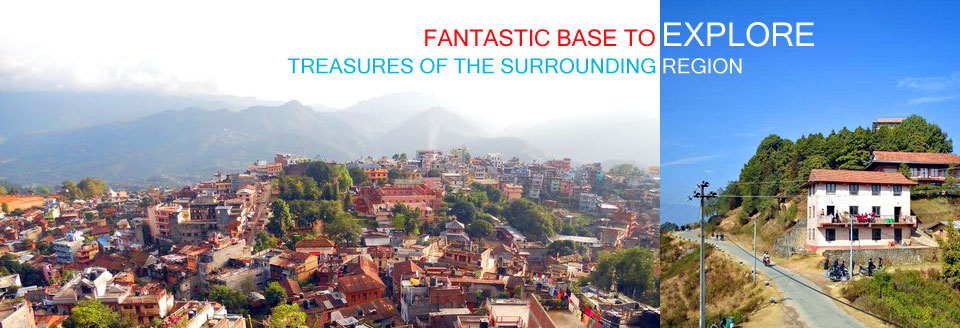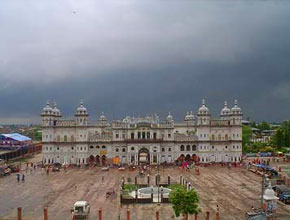










JANAKPUR
Terai’s most fascinating city, historically called Mithila, more commonly Janakpur presently headquarter of both Janakpur zone and Dhanusha district, was the capital of King Janak’s ancient Mithila Kingdom during the Treta Yug, or Period, nearly 12,000 years ago. An important pilgrimage site for Hindus, Janakpurdham is dominated by the impressive Janaki Temple, an obligatory stop on the Hindu Pilgrimage circuit. Janakpurdham, has its own language and script.The most important historical reference to Mithila/Janakpurdham is the Hindu epic of Ramayana. The Maithali language is widely spoken in the area. Janakapurdham is very famous for fish as the city is well known as “City of Ponds”.
ACCESS TO JANAKPUR
> By air: There are regular flights to Janakpurdham from Kathmandu.
> By Land: There are regular buses to Jnakpurdham from different parts of Nepal or Visitors from India may arrive here by Train through Bhittamod, Sitamadi.
ACCOMMODATION
There are a number of good hotels and lodges in Janakpur.
NOTABLE TEMPLE OF JANAKPURDHAM
Janaki Temple:
This magnificent temple of marble was built by Brishbhanu kunwari, wife of King Pratap Singh.This temple takes inspiration from Mughal architecture and is the biggest temple of Nepal. On the four corner of this temple, cupolas enhance its architecture supremacy. The middle portion of the east side is known as ” Sheesh Mahal”.And at the center of the inner part where the idols of Sita and Ram are housed is called the Janaki Mahal.Behind the Janak Mahal is the Janak-Sunaiyana Mandir, dedicated to the father and mother of Goddess Sita. The whole temple complex is also locally known as the Naulakha Temple as Nine lakh rupees. A colossal sum of money then-were said to have been spent in the construction of the Janaki Mandir. On he premises of Janaki Mandir, in the northeast corner lies the Lakshman temple, while the magnificent Vivah Mandap lies to the southeast in the midst of the beautiful garden. In the southeast corner is a park whilde a dharmashala(rest hous) stands to the south of Janaki Mandir.
Shree Ram Mandir:
This pagoda temple was built in 1782 by Amar Singh Thapa, while its glided roof was bestowed by Rana Prime Minister Chandra Shumsher in 1907.This temple, which lies on the western banks of holy Dhanush Sagar and to the southeast of Shree Janmak Mandir, abounds in ancient idols.
Shree Janak Mandhir:
This temple at Janak Chowk is dedicated to King Janak renowed for his scholarship in that age. He was also regarded as “Videh” or someone without a body. Though this temple is comparatively small, it has held great importance in popularization Janakpurdham as the ancient capital city of Vedic Mithila Kingdom.
Dulha-Dulhin ( bridgegroom & Bride):
This temple lies to the west of the Ramananda Chowk, where a magnificent gateway stands with an idol of Shankaracharya on the top. The temple enshrines the idols of Goddess Sita and Lord Ram dressed as bride and bridegroom.
Shree Sankat Mochan Mandir & Rangabhoomi:
This temple is dedicated to Hanuman, the most loyal attendant of Lord Ram & Goddess Sita. Hanuman, the son of the Wind God, is also known by the name of Sankat Mochan, or redeemer of all woes. this temple lies in the northwest corner of the mythological land called “Rangabhoomi” or the Bow-Breaking ceremony, in the Treat Yug. This Hanuman temple sees thousands of devotees twice a week on Tuesday and Saturday.
Jaleshwarnath Mandir:
This temple lies in Jaleswar, the headquarters of Mahottari district, 18 km to the southwest of Janakpurdham. The temple enshrines a Shiva lingam 20 feet below the surface. The phallic symbol of Lord Shiva lies immersed in water, hence its namesake. The temple draws large numbers of devotees from both Nepal and India on Shivaratri, the Night of Lord Shiva, in February, and also during the month of Shrawan(July-August)buses leave regularly to Jaleshwar from Janakpurdaham and Bardibas.
Dhanuhadham:
This place of mythological importance lies 20km to the north of Janakpurdham. It was here that a fragment of Shiva’s divine bow fell after Lord Ram broke it into three pieces during the bow-breaking Ceremony held at Rangabhoomi in Janakpurdham a condition for obtaining the hand of Sita in marriage. During the Maker Mela festival held every Sunday in the month of Magh (January-Febuary), hundreds of thousands of devotees throng Dhanushadham to pay homage to the fossilized bow piece. Buses leave regularly for Dhanushadham from Janakpurdham. One can also reach there from Bhiman to East West Highway – a distance of just 6km.
Shree Laxmi Narayan Mandhir (Matihani):
This temple lies on the north bank of the huge Laxmi Sagar Pond. It is 6 km from Jaleshwar to the south. It was in this pond that the Matakor (Soil digging Ceremony) was performed before the marriage of Sita to Ram. There is also Laxmi Narayan Temple in the area. Another temple here is known for an iron strap used by a hermit called Tasmiya Baba, with engravings on it dating back to about 450 years.
SOME IMPORTANT PONDS OF JANAKPURDHAM:
Ganga Sagar:
Any pilgrimage is incomplete without a ritual bath in this pond which has never dried up. According to popular belief, water from Seven Seas and all sacred places were collected, and this sacred pond called Ganga Sagar took shape.
Dhanush Sagar:
This pond lies in front of Ram Mandir. It is said that the bow which Lord Shiva had given to King Janak during the Treta Yug was kept at this place for safe keeping, and the pond was built in the shape of the weapon. People say that the bow turns a shining red when observed from one corner of the pond while it disappears after prayer and lighting of the ritual flame by the priest of the local temple.
Ratna Sagar:
This pond is to the northwest of Rangabhoomi and Ramanand Chowk. It is said that King Janak used to store jewels in this pond. People say that the bow turns a shining red when observed from one corner of the pond while it disappears after prayer and lighting of the ritual flame by the priest of the local temple.
Agani kunda:
This pond lies about half a kilometer to the southwest of the Ratna Sagar, where yagyas (offering made of a sacred fire) used to take place during Vedic times. Although comparatively small in size to other pond, it is very deep.
UNIQUE CULTURAL DANCE OF JANAKPURDHAM
Jata-Jatin:
This dance is performed at night by a group of rural women in the month of Bhadra (August/September) when there is a drought. The women catch frogs and put them in small pitchers filled with a mixture of water and cow dung. The women divide themselves into two groups – one masquerading as the male, which is called ‘Jata’, and the other as the female and is called ‘Jatin’. The women then place the pitchers on their heads and go about the village, singing a song in question-answer form. At the end, they throw the pitchers into the courtyard of a person assumed to be evil-minded, and then disperse. The cultural dance is performed with the hope that there will be rain.
Jhijhiya :
This festival (on the 6th day of the bright lunar fortnight in Kartik) is the most auspicious festival of Mithilanchal. (Another dance worth watching is performed by a group of women every year in the month of Ashwin (September/October) during the Dashain festival from Ghatasthapana to Vijaya Dashami.)
Sama Chakeba:
This is a play performed by the rural women of Mithilanchal for a fortnight, starting on Chhath in the month of Kartik (October/November) and lasting till the full moon. Through this play, women express their affection to their brothers. Every evening, women leave their homes with dolls in a bamboo basket, in the middle of which they place a burning lamp. They gather at a certain crossing and sit in a circle, singing till midnight. On the final night, they burn the moustache of ‘Chugla’, the evil doll. The dolls are then disposed off amidst the playing of such musical instruments as drums and the flute in the presence of their brothers.
Jharri
This play is performed at the time of ‘Hanuman- Jhand’ (celebration commemorating Lord Hanuman’s flag) and ‘Daha’ or ‘Tajiya’ (Muslim rituals). About 10-15 men perform this dance with a stick that is about 18 inches long. The singing and dancing go on for hours.
Mithila Paintings & Flok Arts:
Mithila paintings are renowed the world over. There is painting centre (Janakpur Woman Development Centre)at Kuwa, Janakpurdham, where nearly Five dozen rural women from different villages are involved in preparing paintings of Mithila folk art for export to Western countries and other markets.
FESTIVALS
Jhoola:
Ritual of placing Ram and Sita on a swing starts from the third day of the brightening lunar fortnight in the main temple of Janakpurdham admist cultural programmes. It is performed daily till midnight and continues till the 14th day of the lunar fortnight.
Chhath:
It is celebrated six days after Deepawali with great devotion and in solemnity. During the celebration, there is harmony in the air, and no distinction is made between rich and poor, caste, creed, and color.
Mathilamadhya Parikrama
(Fortnightly circumambulation of 14 pilgrimage spots stretching 127 km) takes place every year during this month through demarcated areas of Mithilanchal. The pilgrimage includes 14 place of historical and mythological importance including four in bordering Indian Territory.
Holi:
Holi is the festival of colors. It is celebrated next day after the completion of Antargriha Parikrama. It is also called “Phagua” in local language.












